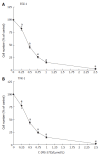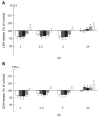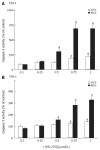Histone deacetylase inhibitor MS-275 alone or combined with bortezomib or sorafenib exhibits strong antiproliferative action in human cholangiocarcinoma cells
- PMID: 17724801
- PMCID: PMC4611578
- DOI: 10.3748/wjg.v13.i33.4458
Histone deacetylase inhibitor MS-275 alone or combined with bortezomib or sorafenib exhibits strong antiproliferative action in human cholangiocarcinoma cells
Abstract
Aim: To investigate the antiproliferative effect of the histone deacetylase (HDAC) inhibitor MS-275 on cholangiocarcinoma cells alone and in combination with conventional cytostatic drugs (gemcitabine or doxorubicin) or the novel anticancer agents sorafenib or bortezomib.
Methods: Two human bile duct adenocarcinoma cell lines (EGI-1 and TFK-1) were studied. Crystal violet staining was used for detection of cell number changes. Cytotoxicity was determined by measuring the release of the cytoplasmic enzyme lactate dehydrogenase (LDH). Apoptosis was determined by measuring the enzyme activity of caspase-3. Cell cycle status reflected by the DNA content was detected by flow cytometry.
Results: MS-275 treatment potently inhibited the proliferation of EGI-1 and TFK-1 cholangiocarcinoma cells by inducing apoptosis and cell cycle arrest. MS-275-induced apoptosis was characterized by activation of caspase-3, up-regulation of Bax and down-regulation of Bcl-2. Cell cycle was predominantly arrested at the G(1)/S checkpoint, which was associated with induction of the cyclin-dependent kinase inhibitor p21(Waf/CIP1). Furthermore, additive anti-neoplastic effects were observed when MS-275 treatment was combined with gemcitabine or doxorubicin, while combination with the multi-kinase inhibitor sorafenib or the proteasome inhibitor bortezomib resulted in overadditive anti-neoplastic effects.
Conclusion: The growth of human cholangiocarcinoma cells can be potently inhibited by MS-275 alone or in combination with conventional cytostatic drugs or new, targeted anticancer agents.
Figures







Similar articles
-
Synergistic induction of oxidative injury and apoptosis in human multiple myeloma cells by the proteasome inhibitor bortezomib and histone deacetylase inhibitors.Clin Cancer Res. 2004 Jun 1;10(11):3839-52. doi: 10.1158/1078-0432.CCR-03-0561. Clin Cancer Res. 2004. PMID: 15173093
-
Bortezomib induces apoptosis and growth suppression in human medulloblastoma cells, associated with inhibition of AKT and NF-ĸB signaling, and synergizes with an ERK inhibitor.Cancer Biol Ther. 2012 Apr;13(6):349-57. doi: 10.4161/cbt.19239. Epub 2012 Apr 1. Cancer Biol Ther. 2012. PMID: 22313636 Free PMC article.
-
Sorafenib alone or as combination therapy for growth control of cholangiocarcinoma.Biochem Pharmacol. 2007 May 1;73(9):1308-17. doi: 10.1016/j.bcp.2006.12.031. Epub 2007 Jan 5. Biochem Pharmacol. 2007. PMID: 17266941
-
Antiproliferative and proapoptotic effects of proteasome inhibitors and their combination with histone deacetylase inhibitors on leukemia cells.Cardiovasc Hematol Disord Drug Targets. 2009 Mar;9(1):62-77. doi: 10.2174/187152909787581372. Cardiovasc Hematol Disord Drug Targets. 2009. PMID: 19275578 Review.
-
Novel molecular targeted therapies for refractory thyroid cancer.Head Neck. 2012 May;34(5):736-45. doi: 10.1002/hed.21755. Epub 2011 May 4. Head Neck. 2012. PMID: 21544895 Review.
Cited by
-
The prostate cancer blocking potential of the histone deacetylase inhibitor LBH589 is not enhanced by the multi receptor tyrosine kinase inhibitor TKI258.Invest New Drugs. 2013 Apr;31(2):265-72. doi: 10.1007/s10637-012-9851-5. Epub 2012 Jul 17. Invest New Drugs. 2013. PMID: 22801803
-
A phase II trial of the proteasome inhibitor bortezomib in patients with advanced biliary tract cancers.Clin Colorectal Cancer. 2014 Jun;13(2):81-6. doi: 10.1016/j.clcc.2013.12.005. Epub 2014 Jan 4. Clin Colorectal Cancer. 2014. PMID: 24512954 Free PMC article. Clinical Trial.
-
Histone Deacetylase Inhibition and Autophagy Modulation Induces a Synergistic Antiproliferative Effect and Cell Death in Cholangiocarcinoma Cells.ACS Omega. 2023 Jun 8;8(24):21755-21768. doi: 10.1021/acsomega.3c01317. eCollection 2023 Jun 20. ACS Omega. 2023. PMID: 37360445 Free PMC article.
-
Precision medicine in cholangiocarcinoma.Transl Gastroenterol Hepatol. 2018 Jul 12;3:40. doi: 10.21037/tgh.2018.07.02. eCollection 2018. Transl Gastroenterol Hepatol. 2018. PMID: 30148225 Free PMC article. Review.
-
A phase I study of the histone deacetylase (HDAC) inhibitor entinostat, in combination with sorafenib in patients with advanced solid tumors.Invest New Drugs. 2015 Feb;33(1):225-32. doi: 10.1007/s10637-014-0174-6. Epub 2014 Nov 5. Invest New Drugs. 2015. PMID: 25371323 Clinical Trial.
References
-
- Vauthey JN, Blumgart LH. Recent advances in the management of cholangiocarcinomas. Semin Liver Dis. 1994;14:109–114. - PubMed
-
- Khan SA, Taylor-Robinson SD, Toledano MB, Beck A, Elliott P, Thomas HC. Changing international trends in mortality rates for liver, biliary and pancreatic tumours. J Hepatol. 2002;37:806–813. - PubMed
-
- Gores GJ. Cholangiocarcinoma: current concepts and insights. Hepatology. 2003;37:961–969. - PubMed
-
- Patel T. Increasing incidence and mortality of primary intrahepatic cholangiocarcinoma in the United States. Hepatology. 2001;33:1353–1357. - PubMed
Publication types
MeSH terms
Substances
LinkOut - more resources
Full Text Sources
Other Literature Sources
Research Materials

